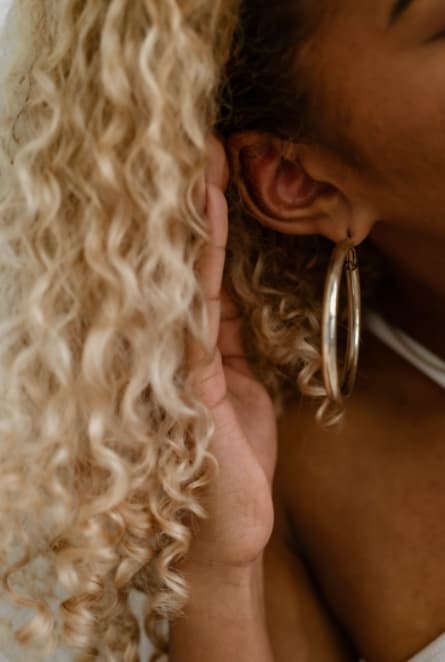Hoop earrings are the perfect finishing touch for any outfit since they are dramatic, eye-catching, and assertive.
While hoops may appear to be the “it” accessory right now, this beloved style has roots stretching back thousands of years.
This article delves into the rich history of hoop earrings, exploring their evolution across diverse cultures and time periods.
Let’s get straight to the point
Hoop earrings have a rich history dating back thousands of years, originating in Nubia around 2500 BCE and embraced by various ancient cultures like the Egyptians, Mesopotamians, and Romans. These societies saw hoops as symbols of power, status, and eternity.
In modern times, hoop earrings resurfaced in the 20th century, particularly among African American and Latina women, as symbols of cultural pride and empowerment.
Pop culture icons further popularised them, while contemporary figures like AOC use hoops to assert identity and defiance. Today, hoops remain a versatile and enduring fashion staple globally.
The Ancient Origins of Hoop Earrings
Where Did Hoop Earrings First Appear?
The tradition of wearing hoop earrings can be traced back to ancient civilisations, where both men and women donned these accessories with pride. Hoop earrings originated in Nubia (modern-day Sudan) around 2500 BCE.
Ancient Egyptians soon adopted the trend, with iconic figures such as Cleopatra and Nefertiti being among the first recorded wearers of hoop earrings. For them, these earrings symbolised power, beauty, and wealth.
Ancient Cultures and Hoop Earrings
In addition to the Egyptians, hoop earrings were also prominent in other ancient cultures such as Mesopotamians, Greeks, and Romans.
These societies embraced hoops as symbols of status, identity, and authority.
The round shape of the earring was not just an aesthetic choice but a symbol of completeness and eternity.
The sun, the moon, and even the womb—all natural sources of life—are circular, representing the cyclical nature of time.
Hoop Earrings Across Different Civilisations
The Symbolism in Ancient Egypt
For the Egyptians, hoop earrings were a mark of nobility and high social standing. Their circular design was seen as a connection to the eternal, much like the sun god Ra.
Egyptian royalty, including Cleopatra, used them as status symbols. The simple yet bold design of the hoop allowed these queens to assert their power and authority.
The Rise of Hoop Earrings in Mesopotamia and Rome
Hoop earrings made their way to Mesopotamia and later to Rome, where they continued to serve as a symbol of status.
Romans wore gold hoop earrings adorned with precious stones to highlight their wealth and power.
As they conquered lands, they also adopted and integrated jewellery styles, further spreading the popularity of hoop earrings.
Hoop Earrings in Asian Cultures
In Asia, particularly among the Hmong people of Southeast Asia, hoop earrings were used to show both cultural and familial identity.
In this context, they represented protection from evil spirits and were commonly worn by both men and women as a display of courage and resilience.
Hoop Earrings in Modern History
The Resurgence of Hoops in the 20th Century
Hoop earrings saw a massive resurgence in the 20th century, particularly in the 1980s.
The fashion of hoop earrings was heavily influenced by African American and Latina women, who used the earrings as a symbol of cultural pride, empowerment, and defiance against societal expectations.
African-American women and Latina women like Chicana feminists embraced the bold, dramatic style as a statement of identity and confidence.
The Influence of Pop Culture
Pop culture in the 1990s and 2000s further cemented hoop earrings as a fashion staple. Celebrities like Jennifer Lopez, Beyoncé, and
Madonna made hoops part of their signature looks, integrating them into mainstream fashion.
Hoop earrings began to symbolise both high fashion and street style, effortlessly transitioning from casual wear to red-carpet looks.
The Political Statement of Hoop Earrings
In modern times, women such as Alexandria Ocasio-Cortez (AOC) have worn hoop earrings as an act of defiance and confidence.
AOC famously wore hoops during her campaign, asserting that hoop earrings are not just fashion statements but representations of her Latina heritage and feminine power.
For many women of colour, hoop earrings are a reminder of their roots and an assertion of their identity in spaces that have historically excluded them.
What Do Hoop Earrings Represent?
Symbols of Power and Identity
Throughout history, hoop earrings have been associated with power, femininity, and social identity.
Their round shape represents eternity, unity, and completeness, reflecting the cyclical nature of life. As bold, eye-catching accessories, they make a statement of confidence and assertiveness.
Cultural Significance Across the World
For many Latina women, hoop earrings are deeply tied to their cultural heritage.
Traditionally, Latina mothers and grandmothers give young girls their first pair of hoops, symbolising their entry into womanhood.
Similarly, for African American women, hoops have become a symbol of pride, identity, and resilience against societal discrimination.
In Australia, while hoop earrings have no indigenous roots, they have become increasingly popular as part of a global trend.
Australian women often choose hoops as a versatile accessory, pairing them with everything from casual streetwear to formal evening attire.
Their enduring appeal lies in their timeless design and ability to complement any look.
The Evolution of Hoop Earrings in Fashion
The Influence of Fashion Icons
Throughout history, influential figures have popularised hoop earrings and integrated them into high fashion.
From Cleopatra to modern-day celebrities, hoop earrings have crossed cultural boundaries and class divides, becoming a versatile piece of jewellery that transcends time and space.
Why Hoops Are Still Popular
The enduring popularity of hoop earrings comes down to their bold design and symbolic meaning. They draw attention to the face, making them a perfect accessory for anyone looking to make a statement.
Hoops also come in various sizes and materials, from gold and silver to acrylic and diamonds, allowing wearers to express their individuality.
Hoop earrings are beloved not just for their appearance but for what they represent. Power, femininity, and cultural pride are just a few of the layers of meaning that have accumulated around hoops over the millennia.
Wearing Hoop Earrings in Contemporary Fashion
Hoops for Every Occasion
While once seen as too bold for certain settings, hoop earrings have evolved to suit every occasion. In Australia, the perception of hoops as casual daytime accessories has shifted.
Now, small and medium-sized hoops are office-appropriate, while larger hoops can still be worn for more dramatic evening looks.
Whether you’re dressing up for a night out or attending a professional event, hoop earrings offer the perfect finishing touch. Their versatility means they can be paired with nearly any outfit, and they remain a global fashion trend.
Choosing the Right Hoop Earrings
Selecting the right hoop earrings can depend on the occasion and your personal style. Smaller hoops offer a subtle elegance, while larger hoops provide a bold statement.
For more formal settings, gold or silver hoops in classic designs are ideal, while coloured hoops or those featuring intricate designs can add flair to more casual ensembles.
Conclusion
From the ancient queens of Egypt to the modern fashion runways, hoop earrings have maintained their place in history as one of the most iconic jewellery styles. They represent not only fashion but also culture, identity, and empowerment.
Whether you see them as a nod to ancient history or a bold modern accessory, hoop earrings remain a timeless piece that will continue to be embraced by future generations.
In Australia, hoop earrings have gained popularity for their versatility, allowing wearers to express both personal style and individuality.
This unique accessory, steeped in centuries of history, will continue to be a symbol of empowerment and fashion for years to come.
Frequently Asked Questions
Who popularised hoop earrings?
Hoop earrings originated in Mesopotamia, and it was ancient peoples of the African civilisation that first wore hoops. Sumerian women around 2500 B.C.E. are believed to be the earliest adopters of wearing hoop earrings.
Who started the big hoop earring trend?
Hoop earrings originated in Africa, dating back to Nubia. According to Yekaterina Barbash, associate curator of Egyptian art at the Brooklyn Museum, this civilisation existed in the fourth century in what is now present-day Sudan. In ancient Egypt, both men and women wore hoop earrings.
Are hoop earrings fashionable?
Timeless: Hoops continue to be a prominent trend in modern times. They will remain fashionable forever as hoops are elegant and make you feel stylish at any age.
Why do Hispanic girls wear hoop earrings?
In Latinx culture, hoops represent the “sazón” of minority groups that wear these accessories to signify and represent their solidarity with their cultural identity. Once seen as low-class and distasteful, hoop earrings have now surfaced as a popular trend among celebrities and fashion shows.



